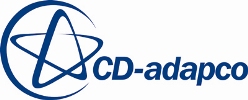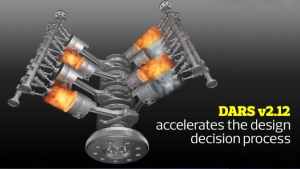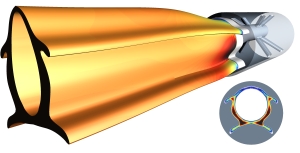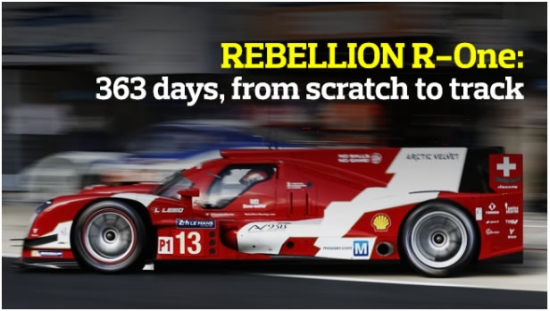 |
|||||
Home > News > Members and Partners News > CD-adapco
| December 14, 2015 - CD-adapco, the largest privately held CFD-focused provider of Computer Aided Engineering software, announced the release of DARS v2.12, its simulation tool for the 0D and 1D management and analysis of chemical reactions. The new release focuses on boosting throughput when exploring new fuel blends under a wide range of operating conditions. The fuel libraries generated with DARS v2.12 can then be used to source combustion analysis carried out with STAR-CD® and STAR-CCM+®. “All of our products are developed to help engineers make the right decisions early in the design cycle. DARS v2.12 enables our customers to predict combustion, chemical processes and emission formation from the earliest stage of the design process, without necessarily having to resort to experimental testing,” said Jean-Claude Ercolanelli, Senior VP of Product Management, CD-adapco. "This release is devoted to enhancing the productivity of our customers, to accelerate their design decision process and to remove all obstacles for innovating.”
The new release, which is now available on the Steve Portal, makes customers more competitive through the software’s enhanced capabilities for productivity. Highlights of the release include:
|
||
| December 4, 2015 -
New release significantly expands STAR-CCM+ application coverage CD-adapco, the largest privately held CFD-focused provider of Computer Aided Engineering software, announced the release of STAR-CCM+® v10.06, its flagship engineering simulation solution. This release features the introduction of Computational Rheology, a new engineering discipline in STAR-CCM+, and forwards the company’s mission to facilitate innovation through Multidisciplinary Design Exploration (MDX) to help customers discover better designs, faster. Computational Rheology further expands the multidisciplinary scope of STAR-CCM+ and targets problems where viscous and viscoelastic effects are dominant. The types of applications that are now possible to solve are flow in static mixers (bread dough food,…), flow into containers (toothpaste, shampoo,…), pumping slurries with significant heat generation, as well as extrusions (foam rubber insulation for door seals, rubber tires,...) and material processing. The capability is built on the same Finite Element (FE) framework as Computational Solid Mechanics delivered in v10.04.
With v10.06, engineers are able to perform two-way fluid-structure coupling from within STAR-CCM+. This tight coupling, easily accessed and deployed from the single user interface in STAR-CCM+, leads to an improved accuracy and ultimately results in better designed products and reduced product failure. Read more This new version also features the ability to compute thermal stress and strains resulting from thermal loads obtained in STAR-CCM+.
STAR-CCM+ v10.06 brings a new and completely revamped interface for the Manual Surface Repair Tool, increasing usability for both the experienced and new user and helping them save significant engineering time. The new interface provides an easier to use and simpler environment for performing manual repair of triangulated surfaces. Experienced users will find that preparing models requires less clicks and makes everything easier to identify and locate. New users will find the new interface easy to navigate and learn. Read more More and more customers are looking to perform simulations on increasingly complex and large assemblies, so it is critical that users can effectively manage their components and workflow. STAR-CCM+ v10.06 brings significant filter improvements, making filtering and selecting of operations, displayers and parts simpler and more intuitive. Read more
Parts-based Interface is a unique capability in v10.06 offering a distinct improvement to performance and scalability using parts-based workflows and resulting in faster simulation turnaround time. This is a key capability for applications which involve many parts such as vehicle thermal management, electronics cooling and heat exchangers. STAR-CCM+ v10.06 also brings significant improvements to geometry preparation by automating the defeaturing process of a detailed CAD model. This release includes a new capability that finds holes and fillets of certain size and removes them from the CAD automatically to get it ready for analysis. As with each STAR-CCM+ release, v10.06 possesses many new features and enhancements drawn from ideas submitted throughIdeaStorm, the innovation forum exclusive to CD-adapco customers. To that end, the company is committed to three major releases each year to ensure it is delivering on its vision for the software and, at the same time, supporting the ongoing needs of its customers. |
||
| November 27, 2014 -
CD-adapco™, the largest privately held CFD focused provider of Computer Aided Engineering software, has been pivotal in the design of the REBELLION R-One LM P1-L car. In 2013, REBELLION entered a partnership with ORECA Technology to design and build the REBELLION R-One, using Toyota engines. In just under one year, 363 days to be exact, ORECA Technology built this state-of-the-art race car which was completely designed from scratch using CAE tools, including STAR-CCM+. ORECA Technology has been using STAR-CCM+ to simulate all aspects of the car, including aerodynamic, hydrodynamic and thermal management. Compared to previous ORECA race car designs, the REBELLION R-One car has been built from a completely clean slate, instead of being forced to make incremental changes to an existing design. The team adopted a ‘no limits [1]’ design philosophy, in which every decision was made with the aim of improving performance. David Floury, ORECA Technology Director commented on the importance of STAR-CCM+ during the design process: "The design bureau started working on the study of this prototype from scratch and completed the project in record time. Only twelve months separate the first initial sketch from the first roll-out! Using STAR-CCM+ was key in the process. We needed a reliable tool, with high precision, allowing a fine work on details and enabling innovation. Also, it is important to rely on previous experiences when conducting such a project, that is why the long-term partnership with CD-adapco has been particularly appreciated. The engineers were aware that the correlation between the CAD and the track would be excellent. We had to be ‘efficient’ just like the technical rules and regulations written by the FIA and the ACO are."
At the 82nd 24 Hours of Le Mans this past June, the REBELLION R-One (car number 12 driven by Nicolas Prost, Nick Heidfeld and Mathias Beche) secured an impressive fourth place overall, beating several factory teams and winning its class overall. Two REBELLION R-One are running in the World Endurance Championship against Audi, Porsche and Toyota, with next race at Bahrain. |
||
| October 7, 2014 - New York and London. September 18, 2014 : CD-adapco, the largest privately held CFD focused provider of Computer Aided Engineering software, today announced its new partnership with Ben Ainslie Racing. The America’s Cup team will be utilizing the CD-adapco simulation tool, STAR-CCM+® in the design of its racing boat. Ben Ainslie Racing team just announced its participation in the 35th America’s Cup taking place in 2017. The focus of the 35th edition of the America’s Cup is sustainability, the set of restrictive rules means this is likely to be the most challenging America's Cup ever from an Engineering Simulation point of view. The introduction of much tighter design specifications, including "one design" components such as a common wing for all contenders, reduces the scope for large design differences between the boats and will likely mean that victory is decided by the smallest of margins. Since the rules will likely prohibit actual sailing of the boats until about 5 months before the competition, most of the important early design decisions will have to be based on data from CFD simulations. Dr.-Ing. Rodrigo Azcueta, Design Engineer for Ben Ainslie Racing commented, "The America's Cup is ultimately a design race, and facing a fresh, three-year campaign, the Ben Ainslie Racing team were determined that they would need the best possible CFD package. So we committed to an extensive evaluation period and benchmarked several CFD providers. At the end of the day we had a clear winner: the power and flexibility of STAR-CCM+; the new optimisation package `Optimate´ added to the outstanding technical support at CD-adapco. Now we look forward to working closely with them and taking our simulation skills to the next level." “Hydroplaning America's Cup boats are as much airplanes as they are boats, so the winning team will have to utilize simulation technology that takes account of the combined effect of aerodynamics and hydrodynamics in order to optimize their designs,” said CD-adapco Executive Vice President Bill Clark. “We call this approach Multi-Disciplinary Design Exploration, and we are delighted that BAR have chosen STAR-CCM+ as a key tool in their quest to win the America’s Cup." |
||
| September 3, 2014 - Computer software accelerates design of next generation advanced automotive batteries New York and London. July 28, 2014 : CD-adapco today announced the successful completion of its development project targeting the automotive and lithium ion battery industries, enabling faster design and development of advanced electric drive vehicle power systems. This project, which began in August 2011, is co-funded by the Vehicle Technologies Office in the U.S. Department of Energy (DOE) and managed by DOE’s National Renewable Energy Laboratory (NREL). This project is part of the competitive Computer Aided Engineering of electric drive Batteries (CAEBAT) activity launched by DOE in 2010. The initial award of the project was reported on July 7th, 2011 and the project team included CD-adapco, Battery Design Inc, Johnson Controls Inc and A123. The methods developed within this program are now available within CD-adapco’s flagship product STAR-CCM+ and also in the application specific tool, Battery Design Studio. These solutions provide seamless integration between electrochemists and thermal engineers within the battery design process. Through linking the flow, thermal and electrochemical simulations into one environment, a highly accurate solution can be obtained. The models also span multiple computational domains from systems models to highly resolved complex 3D models. The image below shows an example of both the thermal and electrochemical results produced for a 12-cell module. Johnson Control’s Director of Controls & Modelling Brian Sisk commented “We are pleased to have worked with our partners on the Department of Energy's CAEBAT project. CAEBAT has provided us with world-class capabilities to model the performance and safety of Lithium-ion batteries. These technologies have helped us design innovative battery systems and enable new fuel-saving technologies for vehicles." Ahmad Pesaran, Energy Storage Group Manager in NREL’s Transportation and Hydrogen Systems Center, added “Continued progress developing and linking physics based models of batteries allows developers and designers to better understand the internal behavior of batteries in electric drive vehicles and explore new designs in a virtual environment, reducing the number of prototypes and tests required by a traditional build-break design cycle. The outcome of this project is expected to enable scientists and engineers to further improve the performance, cost, and lifetime of advanced lithium ion batteries in support of the DOE’s EV Everywhere Grand Challenge.” “We are pleased that our battery simulation tools in STAR-CCM+, developed under the DOE CAEBAT activity, is already being used by a significant number of companies and universities to design battery packs faster,” indicated Steve Hartridge, Director of Electric & Hybrid Vehicles at CD-adapco. For information on the CAEBAT activity and its objectives, please visit: http://www.nrel.gov/vehiclesandfuels/energystorage/caebat.html For more information on the created methods and to obtain a trial license contact your local CD-adapco office at www.cd-adapco.com/locations.
|
||
| September 3, 2014 - STAR-CD and es-ice v4.22 is now available for download New York and London. July 16, 2014 - CD-adapco™, the largest privately held CFD focused provider of Computer Aided Engineering software, today announced the release of v4.22 of STAR-CD® and es-ice™ IC Engine simulation software. The v4.22 release provides extensive refinements to existing physics models and pre-processing developments to deliver rapid and more accurate in-cylinder simulation. es-ice has been enhanced with an automatic meshing capability for full cylinder models. Geometries can now be easily meshed with a minimum of inputs using one simple panel. Additional engine specific results, case details, and simulation settings have been added to the summary report and it is now possible to export an Excel workbook of the complete simulation post results. Automation has been further improved with the addition of several embedded Excel driven scripts. The complete sector simulation process and results animation and plotting processes can now be driven via Excel input and are available directly from within es-ice. Additionally, a full model can now be reflected from a trimmed half model to ensure perfect symmetry of the mesh. The ECFM-CLEH model has been extended to allow combustion of multi-component fuels or dual-fuel engines, including oxygenated fuels. As with ECFM-3Z, the ECFM-CLEH model uses a library-based approach to incorporate the effects of complex chemistry. In addition to the libraries for standard fuels that are delivered to users, it is now also possible for users and other 3rd parties to generate their own fuel chemistry libraries for autoignition, laminar flame speed and equilibrium according to an open format provided by CD-adapco and providing they have appropriate chemistry mechanisms and software. All libraries now use equivalence ratio rather than mixture fraction as one of the independent variables as this is more accurate for engine operating points with substantial EGR. Additionally, the libraries available with the model have been extended in equivalence ratio, pressure and EGR dimensions to provide users with a wider range of engine operation. The robustness of the higher-order MARS differencing scheme has been improved especially for the NORA NOx and soot models whilst maintaining the same computing time. The soot sectional method, which is important for calculating soot size distribution, has been extended to operate with all ECFM and PVM-MF combustion models. The PVM-MF (Progress Variable Model – Multi-Fuel) model, first introduced in v4.20, has seen a number of enhancements for v4.22 release. PVM-MF is a detailed chemistry-based combustion model that is able to operate under low Damkohler number combustion regimes that can occur under lean, rich or high EGR engine operating conditions. It has full 3D cell-based flame resolution, in contrast to zonal or representative flamelet models and can cover premixed, diffusion, HCCI or mixed-modes of combustion. Since its first release, the model has been refined in a number of areas and for dual-fuel operation. Fuel libraries for gasoline, diesel, natural-gas have been updated and an additional library for natural-gas–diesel (dual fuel) are available from Customer Support. This approach gives an extremely efficient and low cost approach to modeling these engine types and it is now also possible to support user fuel libraries and chemistry mechanisms. The evaporation and mixing of complex fuel mixtures is critical to today’s DI gasoline engines. To improve modeling accuracy in these engines, refinements to the existing Raoult’s Law multicomponent model have been introduced to enable the evaporation of ethanol-gasoline mixtures to be better represented. The UNIFAC models, available in STAR-CD v4.22, provide a framework for modeling mixtures where the molecular structure of fuel components is substantially different and is generally applicable to engine bio-fuels. In addition to the Lagrangian spray model, the implementation allows for all aspects of fuel evaporation including impingement and all wall-film regimes. An additional option for heat transfer has been introduced in STAR-CD v4.22. This model provides an easy-to-use and computationally economical method for calculating crank-angle resolved changes in structural temperature and the effect on in-cylinder processes. Changes in surface temperature during the engine cycle can be significant for spray-wall impingement, during combustion and if there is any thermally insulating layer. The model assumes locally 1-dimensional heat transfer within the structure and is solved on multiple 1-dimensional meshes normal to the surface, these being generated internally through the specification of a few simple dimensional and thermal property parameters. Multiple material/layers, including contact resistance, can be incorporated and can be specified independently on all major components, ie the piston, liner, cylinder head and valves. Initial and boundary conditions can be either prescribed by the user or mapped from a cycle-averaged structural solution. STAR-CD v4.22 provides a number of new capabilities to support the continued development of STAR-CD in-cylinder LES capability. Proper Orthogonal Decomposition (POD) is a powerful analysis technique for the quantitative analysis of LES calculations that can used to examine and compare different modes of a nominally cyclically-repeating flow and which is now available to the user. The improved Werner-Wengle wall model, which allows for SGS viscosity effects to be included in the fully turbulent region of the wall boundary layer, is now available. This simple yet effective model has been demonstrated to improve the correlation of wall friction factor. Finally, the discretization of the strain-rate has been improved that demonstrably improves small-scale dissipation. Further evaluation of these new capabilities will continue with CD-adapco IC engine university partners during the coming year. |
||
About CD-adapco CD-adapco (www.cd-adapco.com) is the world’s largest, privately owned CFD-focused CAE provider. Our core products are the technology-leading simulation packages, STAR-CCM+ and STAR-CD. The scope of our activities, however, extends well beyond CFD software development to encompass as wide range of CAE engineering services in fluid dynamics, heat transfer and structural engineering. Our ongoing mission is to “inspire innovation and reduce costs through the application of engineering simulation software and services.” CD-adapco has maintained 15% organic year-on-year growth over the last five years. CD-adapco employs over 900 talented individuals, working at 40 strategic locations across the globe. Press Contact Press Contact, France |



